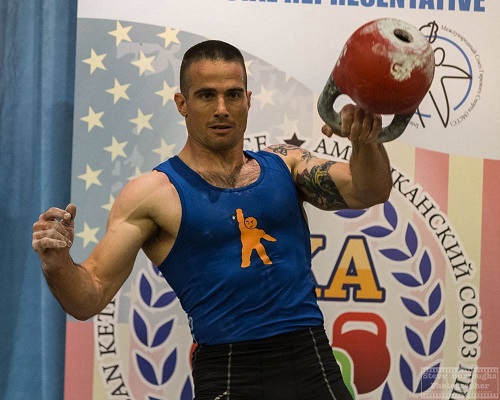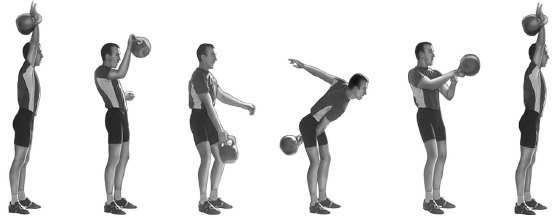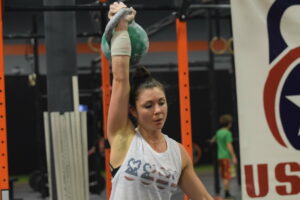KETTLEBELL SNATCH : THE COMPLETE GUIDE
How to perform the kettlebell snatch?
The snatch is a bodybuilding movement in which a kettlebell is lifted explosively from the ground to overhead in a single movement. This kettlebell exercise, very popular in kettlebell workouts, is considered one of the most complete exercises for strengthening the entire body and improving overall fitness.
However, it’s important to point out that the kettlebell snatch can be a complex and difficult movement to execute correctly. Incorrect technique can not only limit the effectiveness of the exercise, but also lead to potential injury. That’s why it’s essential to understand the basic principles and learn the appropriate techniques.
The purpose of this article is to provide a comprehensive presentation of the kettlebell snatch, describing the basic principles, health benefits, different variations of the movement and common mistakes to avoid. By understanding these elements, you will be able to practice the kettlebell snatch safely and with proper technique, allowing you to maximize the benefits of this incredibly effective exercise.
Benefits of the kettlebell snatch
Global muscular reinforcement :
The kettlebell snatch is a complete exercise that involves several muscle groups, such as shoulders, arms, abs, legs and glutes. It helps develop strength and power throughout the body.
Improved overall fitness:
The kettlebell snatch is an intense cardiovascular exercise that can improve your endurance and fat-burning capacity. By practicing snatch regularly, you can improve your overall fitness.
Weight loss and endurance development:
The kettlebell snatch is an exercise that engages multiple muscle groups at once, which can help burn calories and promote weight loss. In addition, it improves endurance and cardiovascular capacity, which can help improve your performance in other physical activities.
Possibility of integrating the snatch into a complete training program:
The kettlebell snatch can be integrated into a comprehensive training program to improve strength, power, endurance and overall fitness. It can be combined with other kettlebell exercises or strength training exercises for a total body workout.
In summary, the kettlebell snatch is an effective movement for improving fitness and strengthening muscles. It can be practiced alone or integrated into a complete training program for optimal results.

The basics of kettlebell snatch
The kettlebell snatch is a movement that requires good technique to get the most out of it. In this section, we will review the fundamentals of the technique to help you execute the snatch correctly.
Starting position
- Feet are about shoulder width apart, kettlebell is placed in front of you
- The knees are slightly bent and the chest is tilted forward (hinge position)
- The back is flat, the abs are engaged and the shoulders are lowered
- The arm is extended, holding the kettlebell firmly by the handle
- The free arm is bent in front of the chest
Execution of the movement
The kettlebell snatch is a movement that must be performed in an explosive, yet controlled manner. Here are the key steps to properly execute the movement:
- Lift the kettlebell off the floor by performing a backswing (passing the kettlebell between the thighs) and swinging the free arm backwards.
- Perform a powerful hip extension to send the kettlebell upward, swinging the free arm upward as well for momentum
- When the kettlebell is halfway down, perform a high pull with your arm to bring the kettlebell up to your face
- When passing the kettlebell in front of the face, perform a vertical ” punch ” to pass the hand inside the handle.
- Lock the kettlebell in an upright position with your arm extended above your head
- Do the opposite way to go backswing, releasing the grip slightly on the way down
Techniques to improve performance
Master the swing:
The swing is a basic kettlebell movement that helps develop the power and coordination needed to properly execute the snatch. By mastering the swing, you can improve your technique and efficiency in executing the kettlebell snatch.
Focus on the trajectory of the kettlebell:
When performing the snatch, it is important to follow a fluid and efficient trajectory of the kettlebell. The kettlebell should move in a straight line to above your head.
Work on your coordination:
The kettlebell snatch requires precise coordination between the arms, legs and torso. To improve your coordination, start by training with a relatively light weight.
Pay attention to your breathing:
Breathing is an important part of kettlebell snatch performance. You should exhale sharply as you lift the kettlebell and inhale as you lower it. This helps maintain good intra-abdominal pressure, which can help strengthen your core and improve your stability.
Practice regularly:
As with any movement, regular practice is essential to improve your technique and performance in the kettlebell snatch. You can start by practicing snatch with a light kettlebell and gradually increase the weight to improve your strength and endurance.

The different variations of the kettlebell snatch
There are several variations of kettelbell snatch, each with its own unique features and benefits. Here is a short description of four popular variations of the kettlebell snatch:
Kettlebell snatch hard style :
The hardstyle variant is the most common kettlebell snatch and is the one whose execution was detailed earlier in the article. It consists of an explosive movement that uses strength and power to lift the kettlebell overhead. The basic technique is to stand with your feet shoulder-width apart, grab the kettlebell with one hand and swing it between your legs. Then propel it upward explosively and stabilize it overhead. The advantages of this variant are the development of strength, power and explosiveness.
Kettlebell snatch sport style:
The sport style variant of the kettlebell snatch is a more fluid and aerial version of the movement. Unlike the hardstyle variant, it requires greater coordination and mobility. The technique consists of using the kinetic energy of the kettlebell to bring it “smoothly” over the head. The benefits of this variant include endurance, mobility and coordination, making it ideal for competition.
Half snatch:
The half snatch variation is a simplified version of the movement, which consists of separating the descent phase into two movements: shouldering the kettlebell then performing the backswing. The half snatch is ideal for saving energy in the biceps and forearm.
Dead snatch:
The dead snatch variant is a version of the movement that focuses more on developing strength and power. It consists of lifting the kettlebell from the ground to overhead using only the strength of the legs and hips, without swinging. The advantages of this variant are the increased development of strength and pulling power.
There are several variations of the kettlebell snatch that can be adapted according to the needs and objectives of each practitioner. By using the proper variant with correct technique, it is possible to improve strength, power, endurance and overall fitness.

8-week training program to progress in kettlebell snatch
Week 1-2:
Day 1: 5 sets of 5 reps of kettlebell swing + 5 sets of 5 reps of kettlebell snatch (alternating arms) with a light to moderate kettlebell. Rest 60-90 seconds between sets.
Day 2: 5 sets of 10 reps of kettlebell goblet squat + 5 sets of 5 reps of kettlebell snatch (alternating arms) with a light to moderate kettlebell. Rest 60-90 seconds between sets.
Day 3: Rest
Week 3-4:
Day 1: 5 sets of 10 reps of kettlebell swing + 5 sets of 5 reps of kettlebell snatch (alternating arms) with a moderate kettlebell. Rest 60-90 seconds between sets.
Day 2: 5 sets of 10 reps of kettlebell goblet squat + 5 sets of 5 reps of kettlebell snatch (alternating arms) with a moderate kettlebell. Rest 60-90 seconds between sets.
Day 3: 5 sets of 10 reps of kettlebell swing + 5 sets of 5 reps of kettlebell snatch (alternating arms) with a light kettlebell. Rest 60-90 seconds between sets.
Week 5-6:
Day 1: 5 sets of 10 reps of kettlebell swing + 5 sets of 10 reps of kettlebell snatch (alternating arms) with a moderate kettlebell. Rest 60-90 seconds between sets.
Day 2: 5 sets of 10 reps kettlebell goblet squat + 5 sets of 10 reps kettlebell snatch (alternating arms) with a moderate kettlebell. Rest 60-90 seconds between sets.
Day 3: 5 sets of 10 reps of kettlebell swing + 5 sets of 10 reps of kettlebell snatch (alternating arms) with a light kettlebell. Rest 60-90 seconds between sets.
Week 7-8:
Day 1: 5 sets of 10 reps of kettlebell swing + 5 sets of 10 reps of kettlebell snatch (alternating arms) with a heavy kettlebell. Rest 60-90 seconds between sets.
Day 2: 5 sets of 10 reps of kettlebell goblet squat + 5 sets of 10 reps of kettlebell snatch (alternating arms) with a heavy kettlebell. Rest 60-90 seconds between sets.
Day 3: 5 sets of 10 reps of kettlebell swing + 5 sets of 10 reps of kettlebell snatch
Conclusion
In this article, we have reviewed the fundamentals of kettlebell snatch, as well as its benefits for overall fitness, weight loss and muscle building. We also looked at the different variations of snatch, including hardstyle, sport style, half snatch and dead snatch.
It is important to remember that the kettlebell snatch is a technical movement that requires careful attention to the starting posture, wrist position, kettlebell trajectory and controlled descent of the kettlebell.

